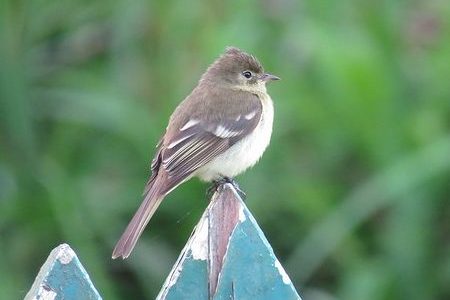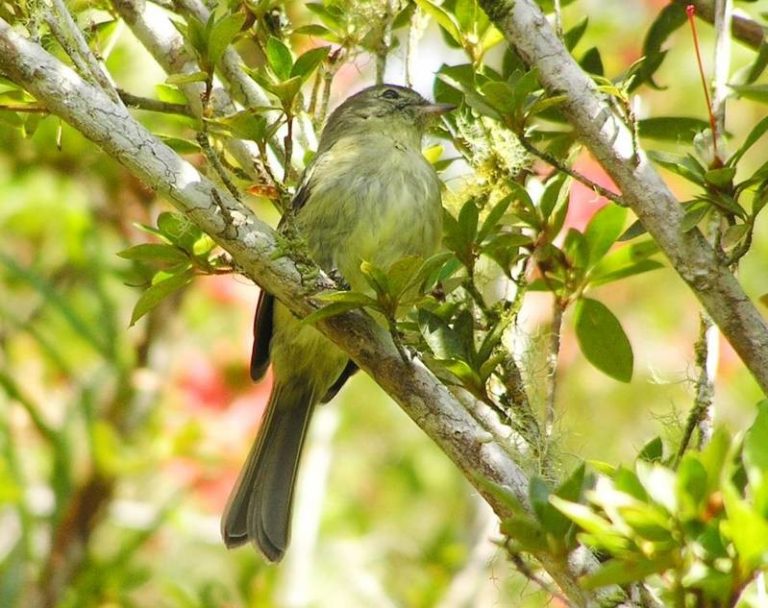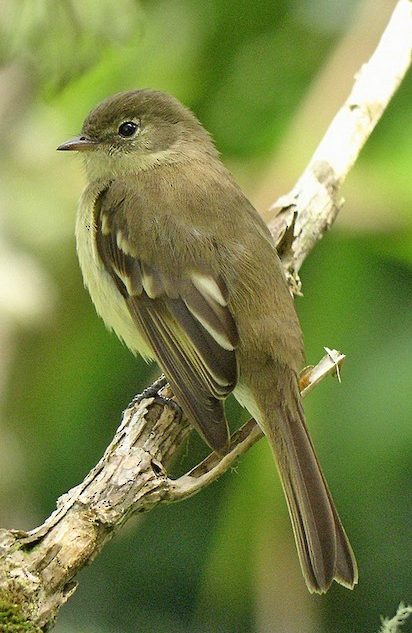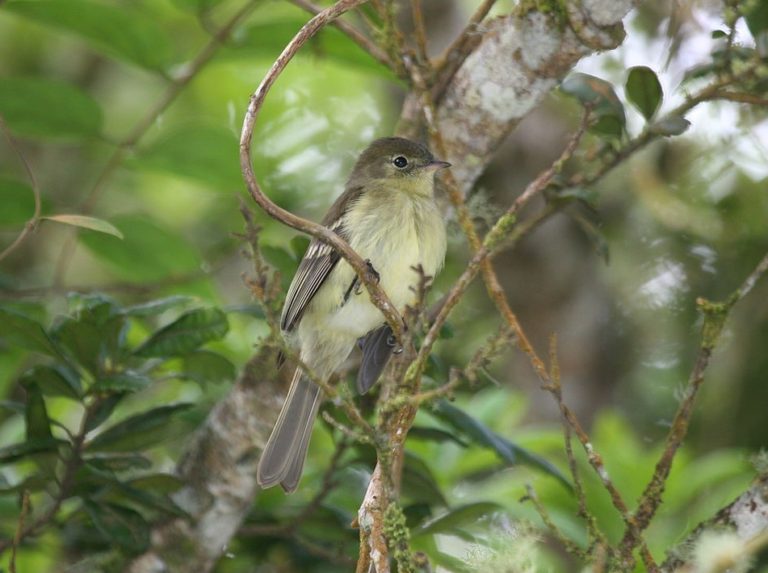Birdfinding.info ⇒ The most accessible sites where this species can reliably be found are Hardwar Gap, Silver Hill Gap, and Portland Gap, where it becomes locally abundant from about April to September. At other times of year, it could possibly be found anywhere in Jamaica, but is generally rare and inconspicuous.
Large Jamaican Elaenia
Elaenia fallax
Family: Tyrannidae
Endemic to Jamaica. Breeds at upper elevations of the Port Royal and Blue Mountains. When not breeding, disperses to forested habitats at lower elevations across much of the island.
Identification
A typical Elaenia: with two bold white wingbars and a proportionately small head. Typically shows whitish facial markings, especially on the lores and behind the eye.
Has a broad white central crown stripe that is usually concealed.
Normally the only plain-olive, wing-barred flycatcher in its range. Jamaican Pewee shows faint wing-bars and usually appears bull-headed. Small Jamaican Elaenia has a prominent white eyebrow and dark eye-stripe, lacks wing-bars, and tends to perch horizontally.

Large Jamaican Elaenia. (Hardwar Gap, Jamaica; May 5, 2013.) © Garrett MacDonald

Large Jamaican Elaenia, showing streaky, yellowish underparts. (Hardwar Gap, Jamaica; December 17, 2006.) © Jan van den Broeck

Large Jamaican Elaenia. (April 18, 2007.) © Richard C. Hoyer

Large Jamaican Elaenia, in a typical view. (Stewart Town, Jamaica; January 27, 2019.) © Matthew Grube
Voice. Typical call is a two-syllable whi-bit! (almost froglike: ribbit) often given in pairs (whi-bit! whi-bit!) or preceded by a chew note: chew whi-bit!
Cf. Migrant Flycatchers. Potentially mistaken for some North American migrant species that are very rarely recorded from Jamaica, such as Eastern Wood-Pewee or Yellow-bellied Flycatcher. Compared to these vagrants, Large Jamaican Elaenia has a more elongated shape, with a proportionately longer tail and smaller head, and a white crown patch that is usually concealed.
Notes
Monotypic species.
Traditionally considered conspecific with Hispaniolan Elaenia, together comprising the Greater Antillean Elaenia, E. fallax, but the two forms differ significantly in vocalizations and genetic markers—apparently indicating definitive speciation.
Frontiers of Taxonomy: Two Species of Greater Antillean Elaenia.
The Elaenias that inhabit the highlands of Jamaica and Hispaniola are very similar in appearance, but close evaluation indicates that they should be recognized as separate species. The strongest support for separate treatment is that their vocalizations differ such that they do not respond to playback of one another’s calls. Mitochondrial DNA analysis has determined that their history of reproductive isolation is comparable to other recognized species in the same genus. (Rheindt et al. 2008)
The Handbook of the Birds of the World Alive adopts this view, dubbing the resulting species Large Jamaican and Hispaniolan Elaenias. In addition to vocalizations and genetic drift, they cite differences in the color of the lower mandible (mostly pink in Large Jamaican; usually dark in Hispaniolan) and underparts (yellowish and streaky in Large Jamaican; grayish or whitish in Hispaniolan).
The cited differences in plumage appear to be inconsistent, as Hispaniolan varies considerably: often grayish but also often yellowish. The bill color is more consistent, but photos show that in some cases Hispaniolan’s lower mandible can be mostly pink. An additional difference not cited in the Handbook, but potentially relevant, is facial pattern: Large Jamaican seems to have consistent markings (whitish below and behind the eye and a narrow loral bar, with a dark cheek patch), whereas Hispaniolan is usually unmarked, or in any case rarely shows the same pattern.
References
eBird. 2019. eBird: An online database of bird distribution and abundance. Cornell Lab of Ornithology, Ithaca, N.Y. http://www.ebird.org. (Accessed February 19, 2019.)
Haynes-Sutton, A., A. Downer, R. Sutton, and Y.-J. Rey-Millet. 2009. A Photographic Guide to the Birds of Jamaica. Princeton University Press, Princeton, N.J.
Hosner, P., and G.M. Kirwan. 2019. Large Jamaican Elaenia (Elaenia fallax). In Handbook of the Birds of the World Alive (J. del Hoyo, A. Elliott, J. Sargatal, D.A. Christie and E. de Juana, eds.). Lynx Edicions, Barcelona. http://www.hbw.com/node/57155. (Accessed February 19, 2019.)
Raffaele, H., J. Wiley, O. Garrido, A. Keith, and J. Raffaele. 1998. A Guide to the Birds of the West Indies. Princeton University Press, Princeton, N.J.
